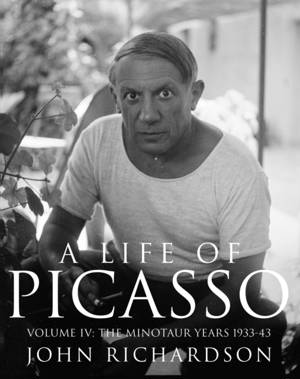
Je cadeautjes zeker op tijd in huis hebben voor de feestdagen? Kom langs in onze winkels en vind het perfecte geschenk!
- Afhalen na 1 uur in een winkel met voorraad
- Gratis thuislevering in België vanaf € 30
- Ruim aanbod met 7 miljoen producten
Je cadeautjes zeker op tijd in huis hebben voor de feestdagen? Kom langs in onze winkels en vind het perfecte geschenk!
- Afhalen na 1 uur in een winkel met voorraad
- Gratis thuislevering in België vanaf € 30
- Ruim aanbod met 7 miljoen producten
Zoeken
€ 48,95
+ 97 punten
Uitvoering
Omschrijving
The beautifully illustrated, long-awaited final volume of John Richardson's magisterial Life of Picasso, drawing on original research from interviews and never-before-seen material in the Picasso family archives.
The Minotaur Years opens in 1933 with a visit by the Hungarian-French photographer Brassaï to Picasso's château in Normandy, Boisgeloup, where he would take his iconic photographs of the celebrated plaster busts of Picasso's lover Marie-Thérèse Walter. Picasso was contributing to André Breton's Minotaur magazine and spending time with the likes of Man Ray, Salvador Dalí, Lee Miller, and the poet Paul Éluard, in Paris and the south of France. It was during this time that Picasso began writing surrealist poetry and became obsessed with the image of himself as the mythic Minotaur.
Richardson shows us the artist being as prolific as ever, painting Walter, as well as the surrealist photographer Dora Maar, who became a muse, collaborator and lover. The bombing of Guernica in April 1937 would inspire Picasso's vast masterwork of the same name, which he painted in just a few weeks for the Spanish Pavilion at the Paris World's Fair. When the Nazis occupied Paris in 1940, Picasso chose to remain in the city despite the threat that his art would be confiscated. In 1943, Picasso met Françoise Gilot who would replace Maar and inspire a brilliant new sequence of paintings.
As always, Richardson tells Picasso's story through his work, analysing how it shows what the artist was feeling and thinking. His fascinating and illuminating narrative immerses us in one of the most exciting moments in twentieth-century cultural history, and brings to a close the definitive and critically acclaimed biography of one of the world's most celebrated artists.
The Minotaur Years opens in 1933 with a visit by the Hungarian-French photographer Brassaï to Picasso's château in Normandy, Boisgeloup, where he would take his iconic photographs of the celebrated plaster busts of Picasso's lover Marie-Thérèse Walter. Picasso was contributing to André Breton's Minotaur magazine and spending time with the likes of Man Ray, Salvador Dalí, Lee Miller, and the poet Paul Éluard, in Paris and the south of France. It was during this time that Picasso began writing surrealist poetry and became obsessed with the image of himself as the mythic Minotaur.
Richardson shows us the artist being as prolific as ever, painting Walter, as well as the surrealist photographer Dora Maar, who became a muse, collaborator and lover. The bombing of Guernica in April 1937 would inspire Picasso's vast masterwork of the same name, which he painted in just a few weeks for the Spanish Pavilion at the Paris World's Fair. When the Nazis occupied Paris in 1940, Picasso chose to remain in the city despite the threat that his art would be confiscated. In 1943, Picasso met Françoise Gilot who would replace Maar and inspire a brilliant new sequence of paintings.
As always, Richardson tells Picasso's story through his work, analysing how it shows what the artist was feeling and thinking. His fascinating and illuminating narrative immerses us in one of the most exciting moments in twentieth-century cultural history, and brings to a close the definitive and critically acclaimed biography of one of the world's most celebrated artists.
Specificaties
Betrokkenen
- Auteur(s):
- Uitgeverij:
Inhoud
- Aantal bladzijden:
- 320
- Taal:
- Engels
- Reeks:
Eigenschappen
- Productcode (EAN):
- 9780224031226
- Verschijningsdatum:
- 30/04/2022
- Uitvoering:
- Hardcover
- Afmetingen:
- 190 mm x 240 mm
- Gewicht:
- 1128 g

Alleen bij Standaard Boekhandel
+ 97 punten op je klantenkaart van Standaard Boekhandel
Beoordelingen
We publiceren alleen reviews die voldoen aan de voorwaarden voor reviews. Bekijk onze voorwaarden voor reviews.









